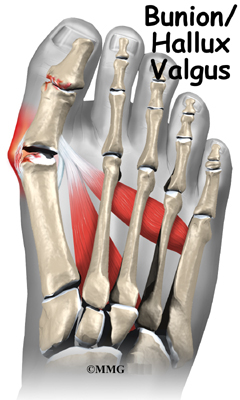
Bunions (Hallus Abducto Valgus) are a common foot problem that affects the joint at the base of the big toe (first metatarsophalangeal joint). In Latin “bunion” means enlargement, while “hallux abducto valgus (HAV)” refers to a bending inwards of the big toe as seen on the image.
As you see, the big toe bends in towards the other toes while the bone behind it (1st metatarsal) pushes outward. This creates a considerable amount of stress on the joint (first metatarsophalangeal joint). Due to this bending inwards, a sharp angle at the big toe joint is created, resulting in the formation of a bunion. Initially, this enlargement is composed of swollen tissue which becomes irritated by any external pressure (for example tight shoes). Eventually this swollen tissue thickens to form a very large lump or bunion.
There is an obvious relationship between bunions and shoes, since bunions do not occur in cultures that go barefoot. High heels, pointed shoes, ballet shoes, excessively tight shoes, and even cowboy boots often lead to the development of bunions.
Anatomy and Biomechanics
From a biomechanical perspective, bunion formation creates a cycle of dysfunction. As the bone behind the big toe (1st metatarsal bone) moves outwards, the inner arch of the foot becomes unstable and starts to collapse. This instability, or lack of support in the arch, increases stress on the angle at the point where the bunion is forming. This stress accelerates the formation of the bunion, which in turn further destabilizes the arch of the foot. To truly deal with this problem, you must address both the foot instability and joint angle.
In addition to the stresses caused by poor shoes, simply walking with your feet in a turned out position can also lead to bunion formation from the stress it puts on two particular muscles. This “turned out” position leads to an imbalance between two muscles - the adductor hallicus and the abductor hallicus.
The adductor hallicus is an interesting muscle which is shaped like the number seven. The adductor hallicus transverses from several of the lateral toes into your big toe. When the adductor hallicus contracts, it pulls the big toe towards the 2nd toe.
· For those of you who have been asking for a more technical anatomical description…well here you go! The adductor hallicus has two heads - the oblique and lateral head. The oblique head originates in the 2nd, 3rd, and 4th metatarsals. The tranverse head originates from the 3rd, 4th, and 5th toes (metatarsophalangeal ligaments). Both heads insert into the big toe (lateral sesamoid bone at the MP joint, and into the proximal phalanx of the big toe).
When the adductor hallicus muscle becomes tight and restricted, it continually pulls the big toe towards the second toe (even without contracting). The adductor hallicus tends to become restricted in individuals who excessively pronate or walk with their feet turned outwards (a huge percentage of runners and dancers).
This pulling action of the adductor hallicus disrupts a key balance in muscle tension, which normally keeps the big toe in a neutral or straight position. This balance occurs between the adductor hallicus and the abductor hallicus muscles.
The abductor hallucis normally resists the pulling action of the adductor hallicus. The abductor hallucis runs from your heel (calcaneus) to your big toe (proximal phalanx). Constant pulling from the adductor hallicus weakens and overstretches the abductor hallucis. Without the appropriate counter-balancing action of the abductor hallucis, the big toe moves inward, and bunion formation accelerates.
In part two of Bunions – Hallus Abductor Valgus, I will disuss: Symptoms, Diagnosis, some Treatment possibilities.
If you would like information about our clinic in Calgary Alberta please go to www.kinetichealth.ca.
(COPYRIGHT KINETIC HEALTH 2012 – ALL RIGHTS RESERVED)
toenail have been a very important part of our body and they are thought of being a mirror to one’s health.Any disorder that one may seize in the nails,that is out of common than the normal fingernails look,must be taken into consideration.
ReplyDeleteSo we must use all below treatment.
Using a toenail clipper that has straight edge will help in cutting the toenails properly leaving no room for any in-growth.
Did you look at our page on bunions treatment?
ebunionstreatment.com